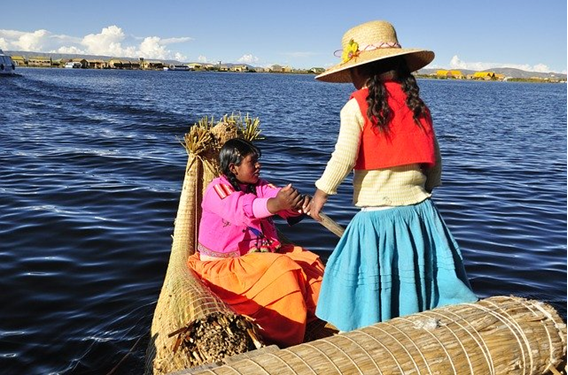


Lake Titicaca in Puno
is one of the essentials on any trip to Peru. Why?
Titicaca is the highest
navigable lake in the world and is located at 3,800 meters above sea level. Its
blue and very calm waters are easily confused with the beautiful sky of the
city. A trip to heavenly paradise!
Likewise, you can
experience experiential or rural tourism in the famous floating islands, which
are made from totora (a typical aquatic plant of the area):
To get to the islands
of Uros, Taquile and Amantaní -the most famous of the place- you have to travel
by boat for approximately 2 hours. These islands are inhabited by ancient
descendants of the Aymara, where families have built their own houses, markets,
and schools on totora.
These communities
demonstrate their deep roots in their ancestral culture, with their native
languages, clothing, dances, typical foods and way of life in general.
Likewise, they live from fishing, handicrafts and still do trade through barter
(exchange that was carried out in Inca times).
What's more, your
experience can end with an offering to Mother Earth, which the inhabitants will
show you.
Lake Titicaca in Puno
is one of the essentials on any trip to Peru. Why?
Titicaca is the highest
navigable lake in the world and is located at 3,800 meters above sea level. Its
blue and very calm waters are easily confused with the beautiful sky of the
city. A trip to heavenly paradise!
Likewise, you can
experience experiential or rural tourism in the famous floating islands, which
are made from totora (a typical aquatic plant of the area):
To get to the islands
of Uros, Taquile and Amantaní -the most famous of the place- you have to travel
by boat for approximately 2 hours. These islands are inhabited by ancient
descendants of the Aymara, where families have built their own houses, markets,
and schools on totora.
These communities
demonstrate their deep roots in their ancestral culture, with their native
languages, clothing, dances, typical foods and way of life in general.
Likewise, they live from fishing, handicrafts and still do trade through barter
(exchange that was carried out in Inca times).
What's more, your
experience can end with an offering to Mother Earth, which the inhabitants will
show you.
Iquitos is an access
road to the Peruvian jungle, where you can only get there by plane or boat. It
is a city covered with a green blanket and majestic mighty rivers, which offer
you an impressive experience.
It is a wonder full of
flora and fauna, where an infinity of species coexist in their natural habitat:
reptiles, bears, monkeys, cats, birds and other species. Here you can also do
ecological and experiential tourism, experiencing sensations when having close
contact with nature and interacting with wild animals.
What else can I know in
Iquitos?
Plaza de Armas,
surrounded by buildings with European influence.
Iron House and some
buildings from the rubber era.
The district of Belén
and its huge street market.
Ayapua Historic Boat
Museum.
Sail through the Amazon
of Peru, the green lung of the world!
Chachani is a volcanic group in southern Peru, 22 kilometres (14 mi) northwest of the city of Arequipa. Part of the Central Volcanic Zone of the Andes, it is 6,057 metres (19,872 ft) above sea level. It consists of several lava domes and individual volcanoes such as Nocarane, along with lava shields such as the Airport Domes. Underneath Chachani lies a caldera. During the Pliocene and early Pleistocene, the volcanic group produced large ignimbrites such as the La Joya, Arequipa Airport and Yura Tuff ignimbrites; afterwards the volcanic group proper grew in the caldera until about 56,500 years ago. There have not been any eruptions during historical time, but the volcano is considered to be only dormant and due to its closeness to the city of Arequipa is considered high risk.
PERU ULTIMATE EXPEDITION
PERU AREQUIPA TOURS
AREQUIPA TOURS